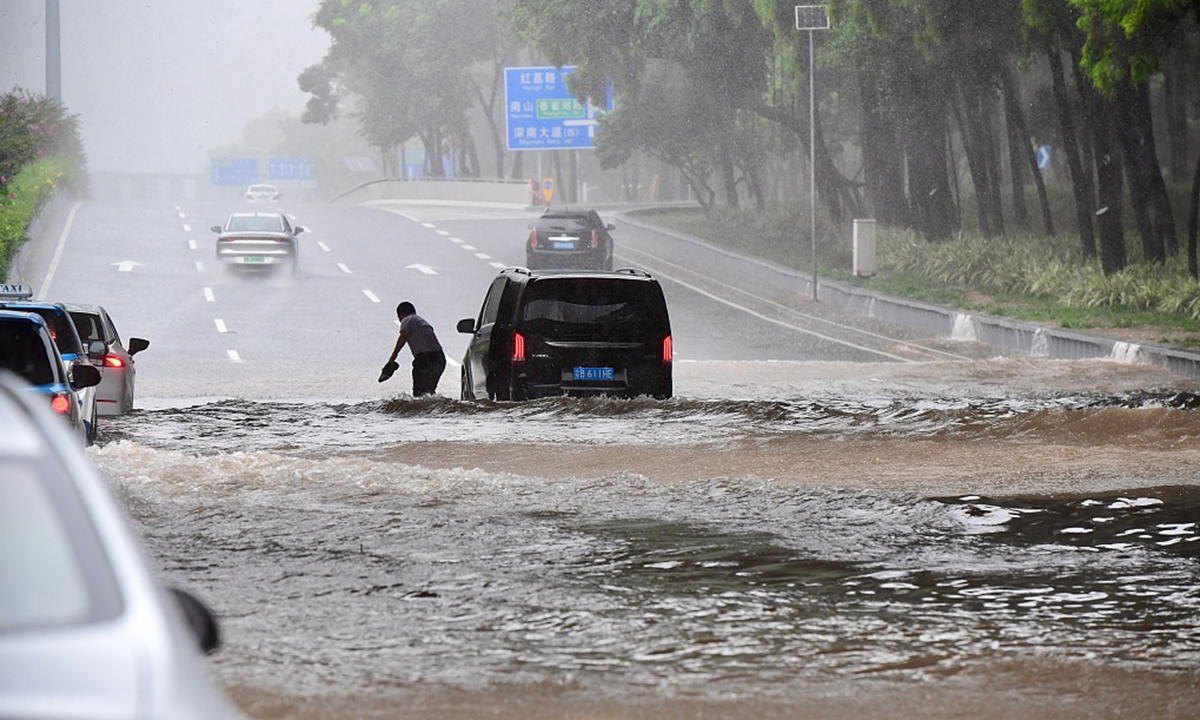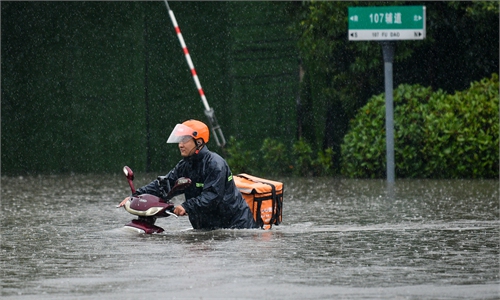South China's Guangdong issues 50 weather alerts, cancels nearly 1,000 flights as double typhoons to hit the area

Heavy rainfall hits Shenzhen, South China's Guangdong Province on July 20, 2021. Photo: CFP
Over 50 typhoon alerts went into effect in South China's Guangdong Province on Tuesday, and several coastal cities raised their alert levels to the highest, as double typhoons including Typhoon Cempaka, the first typhoon making landfall in China this year, were barreling toward the region with torrential rains, strong waves of up to 4.5 meters, and strong winds expected on Tuesday night and Wednesday.
Nanfang Daily reported that 990 flights in Guangzhou, Shenzhen and Zhuhai, three major cities of Guangdong, had been canceled as of Tuesday afternoon.
Cempaka arrived in Yangjiang, Guangdong, around 9 pm on Tuesday, according to Guangdong weather bureau.
Cempaka will bring rains and gale winds to east and west Guangdong and the Pearl River Delta until Thursday, increasing the risk of disasters such as water-logged areas, mountain torrents, mudslides and landslides, Guangdong weather authorities said.
Guangdong recalled fishing vessels and told fish-farming workers to move to shore, while cities including Zhuhai and Zhongshan suspended classes for kindergartens, primary and middle schools on Tuesday.
On Tuesday, Yangxi, Yangjiang and Taishan issued typhoon red alerts, and Maoming and Dianbai issued orange alerts.
Guangdong Province has also issued nine yellow alerts, 27 blue alerts and 13 white alerts. Guangdong has a five-tier, color-coded weather warning system, with red representing the most severe, followed by orange, yellow, blue and white.
Meanwhile, the Guangdong weather authorities said that Typhoon In-Fa is approaching the coastal areas of East China's Zhejiang Province and Fujian Province, which neighbors Guangdong, indicating the likelihood of a binary typhoon.
According to a statement the National Marine Environmental Forecasting Center sent to the Global Times on Tuesday, affected by Cempaka, the northwest area of the South China Sea is expected to witness huge waves of 4 to 6 meters from Tuesday night to Wednesday, and waves of 3 to 4.5 meters will be seen off the west coast of Guangdong.
Affected by In-Fa, the south area of the East China Sea is expected to see strong waves of 6 to 10 meters and the coastal waters of the provinces of Zhejiang and Fujian will see waves of 2 to 3 meters.
A local resident in Yuexiu district in Guangzhou who gave her name as Quanquan told the Global Times that people still went to work and commuted normally on Tuesday. Her confidence came from the constant improvement of the city's drainage system, she said.
"I have been in Guangzhou for four years since I came here as a post-graduate student, but I never see the city get flooded by heavy rain. "
According to the Ministry of Agriculture and Rural Affairs, the two typhoons would influence each other, and the impact on agricultural production cannot be estimated as the exact landing times and intensity levels of the two typhoons were still uncertain.
"It's a critical period for the early rice harvest and jointing of middle rice in South China, and is an important period for livestock production and the mid-summer moratorium on fishing. The rains and strong winds due to the typhoons would have a negative impact on agricultural production," the ministry said on Monday.
Yang Fuqiang, a senior advisor on climate and energy with the Beijing-based consultancy Natural Resources Defense Council, told the Global Times on Tuesday that the coastal regions in South China will be affected by typhoons until the end of September, which will affect regions including Guangdong and Fujian.
As a Fujian resident, Yang said that the local authorities and people have rich experience in dealing with typhoons each summer, and the mobilization of local people could ensure the supply of food and vegetables for communities.


